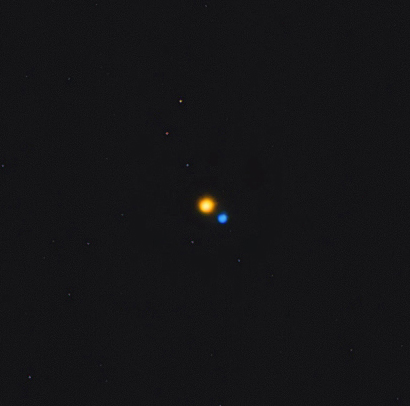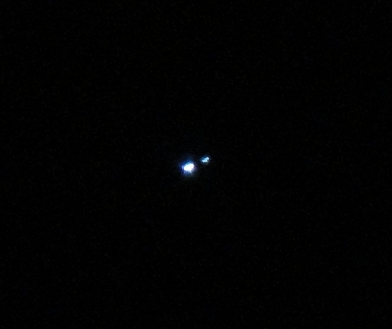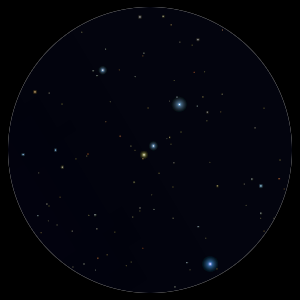In some cases the stars are of different types or sizes, so they make a striking pair when you look at them through telescope or binoculars. With half the stars in our galaxy being in multi-star systems, these pairs can be found all over the sky. I've found that the colors in stars are different through different sized scopes, certain colors are more intense with different diameters of scope. So it's interesting to look at the same pair of stars through different scopes on the same night to see how they look through each.
Albireo
Visually, Albireo is the star at the head of Cygnus the Swan. It's easy to see most of the year in northern latitudes. Through binoculars or telescopes the colors of the stars make for a striking contrast. One star appears as blue or white, depending on the night and your instrument. The other ranges from a deep amber or orange to a fair yellow. Whenever we're at a star party, if my wife hears that Albireo is in somebody's scope, she rushes over for a look at this celestial gem.

Albireo, image by Hewholooks
Use low magnification (<100x) on Albireo if you're using a telescope. You might want to take a second look at a medium level of magnification (about 100x) to see if there's a color change at this level.
Cor Caroli
Cor Caroli, "Charles' Heart", is what folks usually expect to see when you say "double star". The stars are of very different brightness, and it takes just a bit of effort to see the dimmer star in the glow of the brighter star. Low magnification will reveal the dimmer star, I usually show this star at 40x. Medium levels of magnification will make it easier to pick out the companion, but will tend to make the difference in brightness not as strong.

Cor Caroli
Visually, Cor Caroli is the brightest star in Canes Venatici, under the curve of the Big Dipper's handle. It's visible year-round in northern latitudes.
Algeiba
Algieba, or Gamma Leonis, is another pair with fine color. It's part of the backwards question-mark that forms the head and chest of Leo the Lion. It's the lower star in the back of the curl of the question mark.

Algieba, image by Roberto Mura
Binoculars will reveal the double, but I prefer to view it at low powers in a telescope.
Omega Scorpii
This is another blue-yellow pair in Scorpius, just a bit toward the head of the Scorpion from the northern claw. It's visible from both northern and southern hemispheres.

Omega 1 and Omega 2 Scorpii, image by Roberto Mura
This pair is widely separated, almost as much as the width of the Moon. View at low magnifications, or with binoculars. The entire area of sky around them is magnificent through binoculars.


